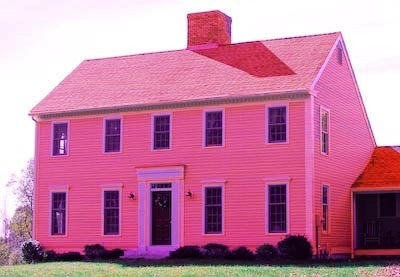What Works Well Behind The Signage Wall
They say there is no such thing as bad press. But have you seen HOAs in the news lately?
Embezzlements of Association funds. Fraud. Rigging of Board elections. Homes foreclosed over late Association dues. Lawsuits. Neighborhood wars. Social media fights that diminish property values.
The American managed community has turned into a salacious suburban soap opera that reality show producers couldn’t top.
That is what my series on the subject – HOAs Gone Haywire – is about. After all, if things were fine and dandy in the world of managed communities there’d be nothing to write about.
Mayhem was certainly not the original intent for managed communities.
Common interest communities – such as Homeowners’ Associations, Condominium Associations, retirement communities, vacation timeshares, and gated subdivisions – were and are intended to give residents a degree of control over their property values and their quality of life that homeowners in non-Association communities simply do not have. Behind those gates there is some measure of control -- after all in a managed community you can do something about a neighbor who paints their house fuchsia or who has a relative who parks a plumber’s van by the curb. In non-managed communities, you can’t.

In a managed community you can do something about a neighbor who paints their house fuchsia. In a non-managed community, you have to live with it or get out of dodge.
In my experience -- having managed hundreds of communities over the last 2 decades -- 80% of the reason people buy into managed communities is to have that level of control…to live with certainty that there will never be a car put up on blocks across the street, or, if there is, it won’t be there for long.
And the deeper reason for that level of control is to protect property values – to help uphold the investments of homeowners. When you consider that, for Americans, equity in their home tends to be their biggest investment, the property value bulwark that a managed community provides is especially appealing. That’s because a fuchsia house or a gnome garden isn’t just an eye sore – it’s a drag on your home’s price tag if you decide to sell.
Which brings me to something I have not addressed in this series, which is why managed communities are so popular in the first place. After all, 68 million people and climbing currently reside in some kind of common interest community, up from 2.1 million in 1970. The number of community associations grew from 10,000 to over 338,000 in the same time period. So managed communities must be doing something right.
Let’s face it though: common interest communities are for a certain personality type. Individuals who don’t want to answer to anyone – who wouldn’t even return a text from a neighbor asking them to de-weed their yard – are not the best fit.
Type A personalities who are willing to concede a degree of control over their own territory in exchange for knowing that everybody’s yard has to be de-weeded or they will be fined are well suited to managed communities.
There are other personality factors as well – people who want a neighborhood experience, people who want family friendly communities, and people who want to identify with their neighborhood are well suited to life governed by an Association.
In other words, those who like a touch of Stepford to their neighborhood experience do well in managed communities. (Note: this article focuses on HOAs. COAs and what makes them tick are a whole other ball of wax, and I will address that in an ensuing article.)
For those who don’t mind Sue across the street having a say in how many potted plants they can have on the porch, then here’s what works well behind the signage wall:
The community always looks ready for its close up: Whether it’s the color of the homes, where the jungle gyms go, what kinds of vehicles can be parked on the street or even how many plants can be on the porches, a managed community is always going to look nice and tidy and, above all, uniform. Eye sores like garage doors that are open and full crap, dead grass, recreational vehicles parked in the yard, and kiddie pools for all eyes to see are suburban heart aches that managed communities keep a serious cap on. So you can be sure if your neighbor decided to decorate their front yard with their dearly departed grandmother’s gnome collection that it won’t be up for long.

A managed community is always going to look nice and tidy and, above all, uniform. So you can sleep well at night knowing that if you come home one day to find that your neighbor has put out their gnome collection that it won’t be up for long.
In addition there will be upkeep of all common areas – there will be a budget to make sure the pond you live behind never turns green, that the median stays mowed, that the giant dead oak tree near the gates that got hit by lightning doesn’t become a permanent fixture to the entry way.
In other words, anything that anyone in the world might consider an eye sore won’t stand much of a chance in a managed community.
You save on country club dues: I see it every day in my role as property manager that homeowners often identify with their community – they’re proud of, they brag about it, they treat it like Shangri La. Much like country clubs provide people a social identification through membership, homeowners in managed communities with a lot of amenities – like a pool, a club house, a gate with a guard -- especially see their community as their primary social network and are proud to say they are a part of it. For sure if you own a home in a managed community you cannot live on your own little domestic island – whether it’s through board meetings, getting that basketball hoop over the garage approved, or hanging out by the community pool, you are intimately involved with your neighbors. So managed communities in general – but especially those with a lot of bells and whistles – are in many ways more than neighborhoods – they are a lifestyle. And with big lifestyle bells and whistles like community pools the cost is shared so you don’t carry the financial burden yourself.

In managed communities with a lot of amenities, such a pool and clubhouse, the neighborhoods become more than neighborhoods – they are a lifestyle.
There’s much less chance of a there goes the neighborhood moment: The guy across the street decides to try to make his high school Camaro that’s been in his parent’s garage for the last 20 years drivable again. He puts it up on blocks out by the curb where he can work on it. He never finishes. The people across the street decide to sell. Nobody wants to see that eyesore on blocks from their living room window, so they have to come down on the price. Then the property values for the whole neighborhood come down a notch. And it keeps going, until you have to sell for less than you paid.
The chances of this going down in a common interest community are very slim. That’s because the CC&Rs that were written by the developer to govern the neighborhood were designed to protect property values above all else. In a common interest community there is recourse in the form of fines and even foreclosures to ensure that no one person can single handedly mar the neighborhood to the point that it affects property values. So managed communities aren’t just homes and neighborhoods – they are investments, and the CC&Rs are designed to protect those investments.

In a managed community fines and even the threat of foreclosure can prevent a neighbor with an aversion to maintaining their lawn and an attachment to old clunkers from single handedly bringing down the neighborhood’s property values.
�
It is true that many HOAs around the country have gone haywire. But it is not because of an inherent problem with the construct and purpose of managed communities. It is because homeowners don’t know how to manage them properly, and they don’t always understand that HOAs are businesses and should be run as such.
But when HOAs are run right what works behind the signage wall makes it all worthwhile. After all, knowing that a neighbor who just moved in cannot just up and decide to decorate the front yard and make it Christmas year round provides the kind of peace of mind that only living in a managed community can buy.
